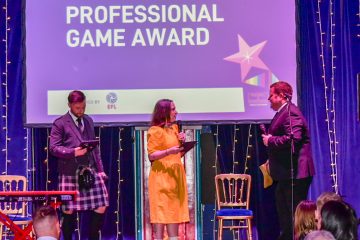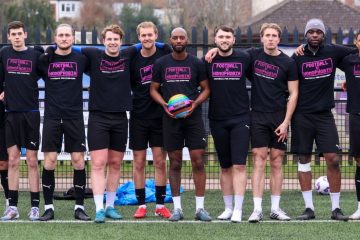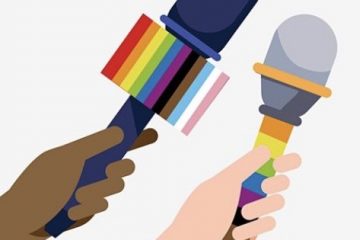Bi Visibility Day: Nakul Pande on coming out, his love of cricket, working at Sky Sports, and LGBTQ representation in media
When Sky Sports News AP Nakul Pande felt “truly and authentically” himself, he posted to his social media accounts to let people know that he is bisexual; on Bi Visibility Day on Saturday 23 September, he joins us for a Q&A to reflect on that moment and on his career in sports media so far, and share some inclusion advice for the industry…

The results of the 2021 Census in England and Wales – the first of its kind in the UK to ask questions about sexual orientation and gender identity to those aged 16 or over – provided several interesting stats about bisexual representation.
628,000 respondents told the Census that they’re bi. We also learned that young people (16 to 24) were almost twice as likely to identify as bi than gay or lesbian; and of the entire bi-identifying population, more than 70% was concentrated in the two youngest age groups between (16 to 24, and 25 to 34).
September 23 is Bi Visibility Day, the conclusion of the annual Bi Awareness Week. At Sports Media LGBT+, we recognise the importance of marking the calendar date and giving a platform to bi voices from our network and extended family.
Nakul Pande is an Associate Producer at Sky Sports News. He joined the company in February 2022, after completing an MA in Sports Journalism at St Mary’s, Twickenham. Nakul has considerable experience as a cricket broadcaster and commentator, having been Assistant Editorial Director at the independent cricket channel, Guerilla Cricket.
In early August, he posted the above image to his social profiles, writing: “I’m bisexual, and I love that for me.” Nakul had connected with us at Sports Media LGBT+ earlier in the year and we’ve been delighted to welcome him into our network and community.
To mark Bi Visibility Day, we invited him for a chat…
Hi Nakul, thanks for taking part in this Q&A. It’s been a few weeks since you posted to your socials about being bi – you wrote about having needed time to learn more about yourself, and about being in a joyful place now in your life. Can you tell us more about the journey that led to you sharing such personal news?
I didn’t actually grow up struggling with my sexuality. It’s true that I had a limited frame of reference for bisexuality and being bi, but as far as I knew I was straight, and that really was fine.
I moved to London for university and settled afterwards, and as I went through my twenties, queer folk made up a greater proportion of my social circle. I often felt more comfortable in spaces both online and in real life that were LGBTQ+-friendly; and despite a lot of my recreational and professional life being around sport, I’d never wanted much to do with ‘sports bro’ culture.
I started noticing as-it-were objective handsomeness in men, and started changing how I dress to try and bring in more colour and pattern because it felt more like me. I met, fell in love with and married my wife, and through her, my social circle got queerer still.
But even to and through turning 30, I remained what I can best describe as a straight agnostic. The phrase I used to define it, both to other people and to myself was, “I’ve never met a man I’m attracted to, but I’m not ruling it out.” It felt intellectually honest, it fit with my worldview, it worked for me… until it didn’t.
One night last November, a new friend was telling me they wanted to start a D&D game for bi people. They asked, “You’re in, right, you’re bi?”, I gave my standard explanation… and for the first time it didn’t feel like me. At all. It kept not feeling like me the next day. This needed some figuring out.
I spent a couple of weeks working out what it all meant. I thought, I read, I examined my feelings… and the best way I can describe it is that I mentally tried on bisexual and it fit. It was snug, and comfortable, and it felt like me. It kept feeling like me the next day, and the next, and the next. I had thought I was straight and that was fine, I now knew I was bi and that was… well, I guess the best word is euphoric.
A few weeks later, I came out to my wife, Lisa. I knew she’d be accepting and loving about it, but she was actively joyful. Over the first half of this year, I started telling friends, almost all some flavour of queer, who I knew would be equally happy for me; the best reaction goes to one of my dearest friends who said she was glad because she’d recently made a straight pal and didn’t have room for any more!
I also made contact with the Sports Media LGBT+ network because I knew that I wanted to live authentically in all parts of my life, including my work. I have to thank you, Jon, for how helpful and welcoming you were to me, and at the risk of this becoming an Oscar speech, I really also want to thank Mark McAdam at Sky Sports for being equally generous and supportive.
I told my immediate family in person; it was important to me that I could do it that way. The next day, I posted my coming out message, and so now I’m ‘out out’.
You mentioned your wife Lisa there and in your social posts – she has excellent photography skills and judgement! What makes the two of you a good team?
Lisa didn’t take that photo for any particular reason – she just thought the moment and the light were right, but as soon as she looked at it, she said, “Hey, you look great in this, you should use it for your post.”
That was a lovely little reflection of the fact that I’m with someone who’s really good for me. Lisa’s a good judge of a person, and it will be utterly unsurprising to anyone who knows either of us that she realised I was bi a good two years before I did.
She pointed this out to me when I came out to her, and she did it with humour and love and it was perfect. We get each other – being with her feels both energising and calming all at the same time.
Cricket is your sporting passion. How has that love for the game influenced your career journey?
It’s been integral to it. I’ve always been very into cricket, and it’s how I got into sports journalism. I stumbled into doing online radio commentary as a hobby, found I had some talent for it, and within a few years, I found myself dreading going into work and looking forward to getting up in the middle of the night to cover a game for free.
By the time the pandemic hit, I had hundreds of hours of commentary under my belt and was ready to pursue a career in sport.
I went back to university to do an MA and get properly trained, and started getting paid commentary work. Then about 18 months ago, I got a chance to apply for a full-time production role at Sky Sports News.
The expansion of my professional horizons since I joined still startles me sometimes. Cricket will, I imagine – and hope – always be my first sporting love, and I do a lot of cricket stories. But the famous CLR James line very much applies: “What do they know of cricket who only cricket know?”
And that’s not just about working on other sports – I’ve always believed my journalistic work would be better and more honest for being more connected to the world that sport exists in, now I’m getting a chance to put that into practice.
Recently, Maia Bouchier spoke about being LGBTQ+ in cricket. She explained how when she initially came out to her parents, she thought she was bi. Later, she identified as gay and is now in a relationship with England beach volleyball player Jess Grimson, who had only dated guys before she met Maia. They did a video together for Team England for Pride Month. What did you take from their story?
It’s interesting that we have a lot of out LGBTQ+ cricketers now in the women’s pro game, but I don’t think any of them have said they’re bi.
I’m not sure whether to be surprised or not about that. Bi erasure in queer communities certainly is a thing, but the strides that women’s cricket has made in queer inclusion in the last decade are enormous and one would hope that bi people would be carried along with that.
It’s pretty remarkable that, a) Steven Davies came out before any female cricketers and, b) despite the fact women’s cricket has multiple married couples at the top level now, we’ll be back down to zero active out male pro cricketers when he retires at the end of the season.
I think in a way, stories like that of Maia and Jess will help expand the perception of what being queer in cricket looks like. Maia said it best: “We have to keep making sure people feel like they can really be themselves.”
While we’re here, I would say that I really like how clearly herself Maia is – that extends to her cricket too, incidentally.
We’ve had some content on the site in each of the last three years to mark Bi Visibility Day. Why is this an important awareness period in the LGBTQ calendar?
No-one reading this needs me to tell them about bi erasure – the myths, the negative stereotypes, the fearmongering, the invalidating from monosexual gay and straight people alike acting as a sort of pincer movement.
So anything that offers a way for bi people, especially in sport which is probably further behind the queer inclusion curve than a lot of other aspects of popular culture (just look at how trans athletes are talked about compared to trans actors), to show that we’re real and here and not apologising for existing is hugely valuable.
Sky Sports has supported Rainbow Laces for several years now. How has that had an impact and what do you feel media companies can do to support LGBTQ inclusion going forward?
I don’t believe that the symbolism and the substantive work are mutually exclusive. In many ways, I think they have to happen simultaneously. But what must not be allowed to happen is brands and leagues and media organisations hiding behind symbolism and no-effort gestures and not actually doing the work.
I think of that great Twitter account that exposes the gender pay gap of every company tweeting some platitude or changing their profile pic on International Women’s Day. The smart companies know that people can smell a lack of authenticity.
It’s been quite depressing to see the pushback on armbands during recent international football tournaments, including boards backing down on One Love which was in itself a compromise to try and accommodate people who were in all likelihood not going to support any visible queer advocacy – and so it proved.

Rainbow Laces and other visibility campaigns can be hugely powerful. We should go where people are and I’m proud the company I work for sees the value in promoting them. My opinion is they’re necessary but not sufficient.
As for what else needs to happen, none of what I’m about to say is hugely original, but we need more LGBTQ+ people working at all levels of the media – public-facing, behind the scenes, boardroom, newsroom, production, creative, all of it. We need people who get it. And we need straight allies to continue to want to learn and listen, and when necessary bring other straight people along with them.
Also, in terms of editorial, we too often miss the joy and liberation that living and working authentically brings, and how powerful a vehicle sport can be for spreading that joy. And when the story isn’t particularly about queer issues but involves queer people, I’m a big fan of matter-of-fact acknowledgment – I love that we can say things like ‘Katherine Sciver-Brunt was audibly nervous as her wife Nat neared her hundred’ or ‘Vivianne Miedema set up her partner Beth Mead to put Arsenal ahead’, in the same way we’d add other bits of context to a report. Let’s normalise it.
Increasingly people talk about intersections and the importance of acknowledging the various identities we inhabit. For anyone who might see parts of themselves in you, what advice would you share?
Firstly, I’m touched by the idea that I might be able to help anyone, or that anyone would ask me – that’s not false modesty, it’s a real honour and one I take seriously. I want to be someone who people would feel comfortable coming to for advice or support or community, and I’m trying to get over the idea that I don’t get to share because I’m new to being out.
For bi men specifically, and South Asian bi men even more specifically, I’d point you in the direction of Vaneet Mehta’s book ‘Bisexual Men Exist’, which among many other things also reflects his experiences as an Indian man coming out. I’m also Indian, but Vaneet’s upbringing was in a far more socially conservative context than mine, and his book is emotional, enlightening and hugely validating.
For so many reasons, I’m in a privileged position, so it was without question easier for me to feel like queer was a thing I could be than it is for a lot of people. Of course, I found it scary even amid all the joy – but I found the idea of not acknowledging and authentically living as who I am far scarier. I was doing it for me, on my own terms, in my own way, on my own timescale – everyone has that right.
You probably know what you need and what you want better than anyone else – trust yourself.
A big thank you from us to Nakul! You can find him on Twitter / X and Instagram.
For more on Bi Visibility Day, check out our content archive. You can also reach out to us in confidence through a DM on social media or on email.
Sports Media LGBT+ is a network, advocacy, and consultancy group that is helping to build a community of LGBTQ+ people and allies in sport. We’re also a digital publisher and can help with your content requirements. Learn more about us here.
We’re interested in your news and stories. Share with us and tap into a worldwide audience through our Google News affiliate website which attracts thousands of visitors, and our popular social channels. Contact us to discuss how we can help you.


